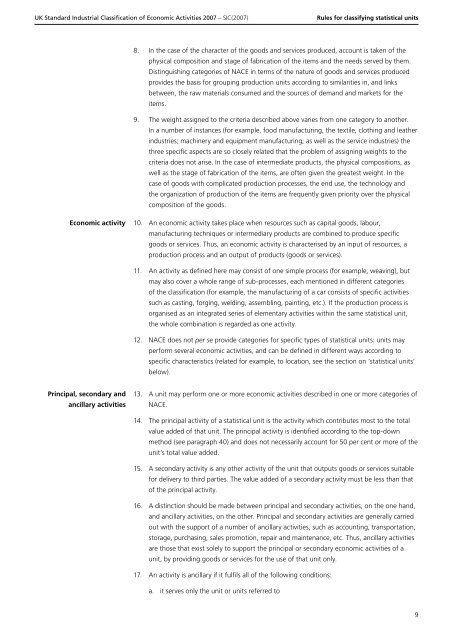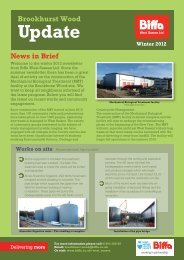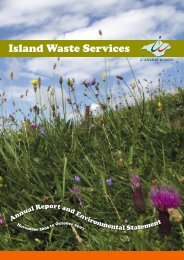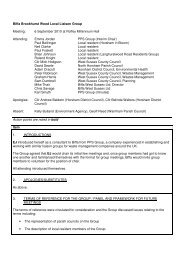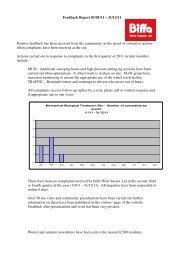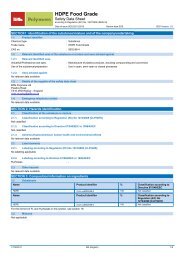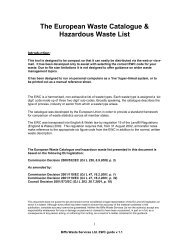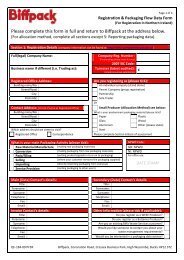detailed explanation for each SIC code - Biffa
detailed explanation for each SIC code - Biffa
detailed explanation for each SIC code - Biffa
Create successful ePaper yourself
Turn your PDF publications into a flip-book with our unique Google optimized e-Paper software.
UK Standard Industrial Classification of Economic Activities 2007 – <strong>SIC</strong>(2007)<br />
Rules <strong>for</strong> classifying statistical units<br />
8. In the case of the character of the goods and services produced, account is taken of the<br />
physical composition and stage of fabrication of the items and the needs served by them.<br />
Distinguishing categories of NACE in terms of the nature of goods and services produced<br />
provides the basis <strong>for</strong> grouping production units according to similarities in, and links<br />
between, the raw materials consumed and the sources of demand and markets <strong>for</strong> the<br />
items.<br />
9. The weight assigned to the criteria described above varies from one category to another.<br />
In a number of instances (<strong>for</strong> example, food manufacturing, the textile, clothing and leather<br />
industries; machinery and equipment manufacturing; as well as the service industries) the<br />
three specific aspects are so closely related that the problem of assigning weights to the<br />
criteria does not arise. In the case of intermediate products, the physical compositions, as<br />
well as the stage of fabrication of the items, are often given the greatest weight. In the<br />
case of goods with complicated production processes, the end use, the technology and<br />
the organization of production of the items are frequently given priority over the physical<br />
composition of the goods.<br />
Economic activity<br />
10. An economic activity takes place when resources such as capital goods, labour,<br />
manufacturing techniques or intermediary products are combined to produce specific<br />
goods or services. Thus, an economic activity is characterised by an input of resources, a<br />
production process and an output of products (goods or services).<br />
11. An activity as defined here may consist of one simple process (<strong>for</strong> example, weaving), but<br />
may also cover a whole range of sub-processes, <strong>each</strong> mentioned in different categories<br />
of the classification (<strong>for</strong> example, the manufacturing of a car consists of specific activities<br />
such as casting, <strong>for</strong>ging, welding, assembling, painting, etc.). If the production process is<br />
organised as an integrated series of elementary activities within the same statistical unit,<br />
the whole combination is regarded as one activity.<br />
12. NACE does not per se provide categories <strong>for</strong> specific types of statistical units: units may<br />
per<strong>for</strong>m several economic activities, and can be defined in different ways according to<br />
specific characteristics (related <strong>for</strong> example, to location, see the section on ‘statistical units’<br />
below).<br />
Principal, secondary and<br />
ancillary activities<br />
13. A unit may per<strong>for</strong>m one or more economic activities described in one or more categories of<br />
NACE.<br />
14. The principal activity of a statistical unit is the activity which contributes most to the total<br />
value added of that unit. The principal activity is identified according to the top-down<br />
method (see paragraph 40) and does not necessarily account <strong>for</strong> 50 per cent or more of the<br />
unit’s total value added.<br />
15. A secondary activity is any other activity of the unit that outputs goods or services suitable<br />
<strong>for</strong> delivery to third parties. The value added of a secondary activity must be less than that<br />
of the principal activity.<br />
16. A distinction should be made between principal and secondary activities, on the one hand,<br />
and ancillary activities, on the other. Principal and secondary activities are generally carried<br />
out with the support of a number of ancillary activities, such as accounting, transportation,<br />
storage, purchasing, sales promotion, repair and maintenance, etc. Thus, ancillary activities<br />
are those that exist solely to support the principal or secondary economic activities of a<br />
unit, by providing goods or services <strong>for</strong> the use of that unit only.<br />
17. An activity is ancillary if it fulfils all of the following conditions:<br />
a. it serves only the unit or units referred to<br />
9


